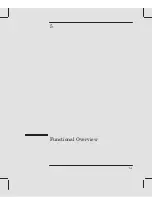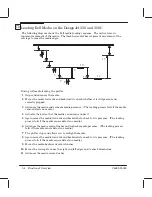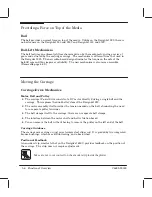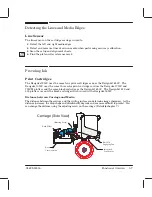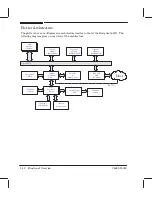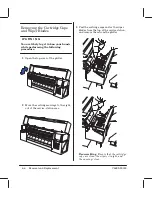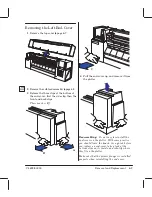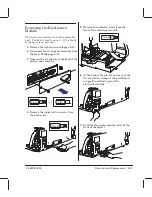
5Ć14 Functional Overview
C4699Ć90000
The plotter firmware code is contained on either an inĆbuilt masked ROM (soldered to the
main PCA) or a flash ROM SIMM (installed in the innerĆmost socket at the back of the
plotter). If both are present, the plotter recognizes the code on the ROM SIMM instead of
that on the inĆbuilt ROM. The powerĆon LED sequence tells you whether the plotter is using
code from inĆbuilt ROM or from a ROM SIMM. (Details
'
page 8Ć3.) To find out the
firmwareĆcode revision level that the plotter is using, print a user setup sheet or a service
configuration plot.
The plotters have a standard four megabytes of onĆboard RAM. They also have one RAMĆ
expansion socket, which can hold an optional 4Ć, 8Ć, 16Ć or 32Ć megabyte DRAM SIMM. The
socket is the outerĆmost one at the back of the plotter.
EEROM is used as nonvolatile storage for calibration and configuration data. Useful
information from the EEROM is printed on the service configuration plot
'
page 8Ć49
(DesignJet 230/250C) or page 8Ć50 (DesignJet 330/350C). The EEROM is soldered to the
Main PCA in both new and rebuilt electronic modules.
If you clear the EEROM or replace the electronics module, perform all calibrations. Also note
that the factory spittoon value on the cleared or new EEROM is 0%. Keep in mind that the
value printed on the service configuration plot may greatly underestimate the amount of ink in
the spittoon. Future PCĆbased plotter diagnostics will enable you to download information from
the old EEROM and upload it to the new EEROM. (Clearing the EEROM
'
page 8Ć54/8Ć55.)
Like the DesignJet 220, the plotters have both a parallel (BiĆTronics) and a serial (RSĆ232ĆC)
interface. Unlike the DesignJet 650C, they have no modular input/output (MIO). You can
connect the plotters to a network by means of an
HP JetDirect EX
or
HP JetDirect EX Plus3
external print server. (See also
'
chapter 1,
w
Network Connections
, and chapter 10,
w
Accessories
.)
In addition to the operating modes of the DesignJet 220, the BiĆTronics interfaces of the
DesignJet 230 and 250C and DesignJet 330 and 350C feature the extendedĆcapabilityĆport
(ECP) forward and reverse operating modes, providing for faster communication.
The supported baudrates are 1200, 2400, 4800, 9600, 19200 and 38400, with eight bits and no
parity, or seven bits with either odd or even parity. Mark parity is not supported. Both
XON/XOFF and DTRhandshaking are supported. ENQ/ACK handshake is not supported.
Summary of Contents for Designjet 230
Page 1: ... ...
Page 3: ... ...
Page 13: ... ...
Page 18: ... ...
Page 19: ... ...
Page 22: ... ...
Page 23: ... ...
Page 25: ... ...
Page 28: ... ...
Page 29: ...3Ć7 Installation and Configuration C4699Ć90000 E A0Ćsize plotters only 32Kg 71 lb ...
Page 31: ... 2 1 ...
Page 32: ... ...
Page 33: ... ...
Page 39: ... ...
Page 43: ... ...
Page 59: ... ...
Page 63: ... ...
Page 64: ... Ensure that the cartridge caps are clean the wipers straight and the openings clear ...
Page 66: ... 2 1 ...
Page 69: ... ...
Page 73: ... Clip ...
Page 76: ... 5 5 mm Torx 15 ...
Page 78: ... Torx 15 Leave loose 5 5 mm Tighten slightly Torx 15 Tighten slightly ...
Page 81: ... Torx 20 ...
Page 93: ... Trailing cable under tabs ...
Page 96: ... ...
Page 103: ... the left and right sideĆplates or the lift mechanism will not work ...
Page 109: ... ...
Page 121: ... GO NO GO ...
Page 135: ... ...
Page 137: ... Flashing Can be On or Off Off On ...
Page 168: ... ...
Page 196: ... ...
Page 197: ... ...
Page 202: ... ...
Page 203: ... ...
Page 207: ... ...
Page 209: ...10Ć7 Parts and Diagrams C4699Ć90000 Top and Back Covers Electronics Trailing Cable ...
Page 211: ... ...
Page 213: ... ...
Page 215: ...10Ć13 Parts and Diagrams C4699Ć90000 CarriageĆAxis Right End ...
Page 217: ... ...
Page 219: ... ...
Page 221: ... ...
Page 223: ... ...
Page 225: ... ...
Page 227: ... ...
Page 233: ... ...
Page 242: ......
Page 243: ... ...
Page 249: ... ...


